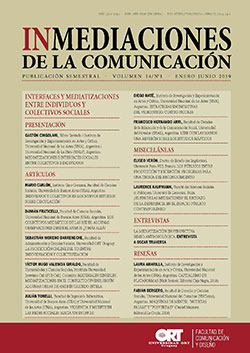Reading with your hands. A review on haptic media studies
DOI:
https://doi.org/10.18861/ic.2019.14.1.2890Keywords:
haptic media studies, touch, mobile communication, navigationAbstract
This article is a review of the existing literature regarding the origins and development of haptic studies in relation to new navigation practices by content proposed by the mobile communication ecosystem in terms of detachment and transformation of the materiality of the supports caused by reading on mobile devices or smartphones. In this way, the renewed forms of navigation have transformed the link between texts, readers and platforms. The perspective of haptic studies takes into consideration the transcendence of the tactile sense in the practice of daily reading. The objective of this article is to bring together the most important authors of this branch of study in order to establish a status of the issue within the framework of mobile communication.Downloads
References
Aguado, J. M., Feijóo, C. & Martínez, I. (2013). La comunicación móvil. Hacia un nuevo ecosistema digital. Barcelona: Gedisa.
Albarello, F. (2018). El consumo transmedia de noticias por parte de estudiantes universitarios”. Informe final de Investigación. Pilar, Buenos Aires: Facultad de Ciencias de la Comunicación, Universidad Austral.
Alonso, E. & Magallanes, S. (2016). Perfiles tecnológicos de los estudiantes universitarios de Periodismo y Comunicación en el contexto de convergencia de las TDCG: estudio de caso en la FACSO-UNICEN. Actas de Periodismo y Comunicación. 2(1), 1-14. Recuperado de: https://perio.unlp.edu.ar/ojs/index.php/actas/article/view/4155
Bourdieu, P. (1991). El sentido práctico. Madrid: Taurus.
Carr, N. (2011). Superficiales ¿Qué está haciendo internet con nuestras mentes? Montevideo: Taurus.
Castells, M. (2009). Comunicación móvil y sociedad. Una perspectiva global. Barcelona: Ariel.
Chartier, R. & Cavallo, G. (2011). Historia de la lectura en el mundo occidental. Montevideo: Taurus.
Cingolani, G. (2013). ¿Qué se transforma cuando hay mediatización? En Rovetto, F. & Reviglio, M. C. (comp.), Estado actual de las investigaciones sobre mediatizaciones. Rosario: UNR Editora. Recuperado de: http://www.cim.unr.edu.ar/archivos/cuadernodelcim2.pdf
Horst, H. A. (2011). Grandmothers, girlfriends and big men: The gendered geographies of Jamaican transnational communication. En L. Fortunati, R. Pertierra, & J. Vincent (Eds.). Migration, diaspora and information technology in global societies (pp. 65–77). London, UK: Routledge.
Ingold, T. (2013). Making. Anthropology, Archaeology, Art and Architecture. Nueva York: Routledge.
Jütte, R. (2005). A History of the Senses: From Antiquity to Cyberspace. Boston: Polity.
Licoppe, C. (2004). Connected presence: The emergence of a new repertoire for managing social relationships in a changing communication technoscape. Environment and Planning D: Society and Space, 22, 135–156.
Littau, K. (2008). Teorías de la lectura. Libros, cuerpos y bibliomanía. Buenos Aires: Manantial.
Mangen, A. (2008). Hypertext fiction reading: haptics and immersion. Journal of Research in Reading, 31(4), 404-419. DOI: 10.1111/j.1467-9817.2008.00380.x
Merleau-Ponty, M. (1993). Fenomenología de la percepción. Buenos Aires: Planeta-Agostini.
Moores, Sh. (2014). Digital orientations: Ways of the hand and practical knowing in media uses and other manual activities. Mobile Media & Communication, 2(2), 196-208. DOI: 10.1177/2050157914521091
Morduchowicz, R. (2008). Los jóvenes y las pantallas. Nuevas formas de sociabilidad. Barcelona: Gedisa.
Muñoz, R. (27 de febrero de 2018). El número de líneas móviles supera por primera vez la población mundial. El País, versión digital. Recuperado de: https://elpais.com/tecnologia/2018/02/27/actualidad/1519725291_071783.html
Pallasmaa, J. (2012). La mano que piensa. Sabiduría existencial y corporal en la arquitectura. Barcelona: Editorial Gustavo Gili.
Parisi, D, Paterson, M. & Archer, J. (2017). Haptic media studies. New Media & Society,19(10), 1513-1522. DOI: 10.1177/1461444817717518
Parisi, D. (2018). Archaeologies of Touch. Interfacing with Haptics from Electricity to Computing. Minneapolis: University of Minnesota Press.
Pernice, K. (2017). F-Shaped Pattern of Reading on the Web: Misunderstood, But Still Relevant (Even on Mobile). Recuperado de: https://www.nngroup.com/articles/fshaped-pattern-reading-web-content/
Richardson, I. (2010). Faces, interfaces, screens: Relational ontologies of framing, attention and distraction. Transformations, 18. Recuperado de: www.transformationsjournal.org/journal/issue_18/article_05.shtml
Richardson, I. & Hjorth, L. (2014). Gaming in Social, Locative and Mobile Media. London: Palgrabe Macmillan.
Richardson, I. & Wilken, R. (2012). Parerga of the third screen: Mobile media, place, and presence. In Wilken, R. & Goggin, G. (Eds.), Mobile technology and place. New York, NY: Routledge.
Scolari, C. (2004). Hacer clic. Hacia una sociosemiótica de las interacciones digitales. Barcelona: Gedisa.
Serres, M. (2013). Pulgarcita. El mundo cambió tanto que los jóvenes deben reinventar todo: una manera de vivir juntos, instituciones, una manera de ser y conocer. Buenos Aires: Fondo de Cultura Económica.
Silva Palacios, M. & da Cunha, R. (2012). A tactilidade em dispositivos móveis: primeiras reflexioes e ensaio de tipologías. Contemporanea. Comunicacao e cultura, 10(3), 668-685.
van Dijck, J. (2016). La cultura de la conectividad. Una historia crítica de las redes sociales. Buenos Aires: Siglo XXI.
Verhoeff, N. (2012). Mobile Screens. The Visual Regime of Navigation. Amsterdam: Amsterdam University Press.





